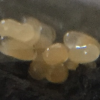Went out and found a Formica francoeuri flight. I sounded the alarm and Drew and Spazz were about to grab some. While I was there, I found these smaller queens and caught about 12 of them.
#1
1. Location of collection: Lytle Creek, CA. Cleghorn rd.
2. Date of collection: 05/28/18
3. Habitat of collection: Creek along a dry mountainous area.
4. Length: 6mm
5. Coloration, hue, pattern and texture: Straight black with a black shiny grey abdomen. It has a shine to it but the abdomen isn't as shiny as Dorymyrmex insanus that I found in the desert.
6. Distinguishing characteristics: Smooth everything. The abdomen is similar to Dorymyrmex in terms of segmentation. It is fairly flat. This thing would just not stop moving and it barely drank the sugar water. I couldn't get a good measurement or side photo.
7. Anything else distinctive: The entire ant reminds me of Pheidole. Flat thorax and even the head shape resembles Pheidole.
8. Nest description: N/A
9. Nuptial flight time and date: 1130-1530
10. Pictures:




#2 is some type of Liometopum
1. Location of collection: Lytle Creek, CA.
2. Date of collection: 05/29/18
3. Habitat of collection: Creek in a canyon
4. Length: 12mm
5. Coloration, hue, pattern and texture: Straight black with a black shiny grey abdomen. The abdomen is incredibly shiny similar to Formica.
6. Distinguishing characteristics: Smooth everything. Possible small short hairs on abdomen but it is hard to tell. It is fairly flat, especially the thorax.
7. Anything else distinctive: Very wide head.
8. Nest description: N/A
9. Nuptial flight time and date: 2030-2230
10. Pictures:





Edited by Scrixx, June 14 2018 - 12:20 PM.




















